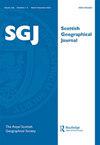苏格兰西南部花岗岩质Criffel–Dalbeattie丘陵的景观演变
IF 2
4区 社会学
Q2 GEOGRAPHY
引用次数: 0
摘要
摘要本文研究了克里费尔-达尔贝蒂花岗岩深成岩体(CDGP)的地貌演化。这项研究基于航天飞机雷达地形任务、谷歌地球、军械调查局地图和实地测量的数据。花岗岩沿加里东构造走向侵位到南部高地,发生在泥盆纪中晚期。晚古生代和中生代的断裂和沉降先于古新世早期假定的岩体差异抬升。这导致了双向古表面的发展。构造控制而非岩性控制形成了古第三纪和新第三纪后续风化的主要基础。CDGP上的浅表风化和无腐泥土意味着风化期可能相对较短。然而,节理增大和原位侵蚀的岩心表明,早期风化特征受到冰川作用的显著改变。更新世冰川事件包括发生在模制山丘上的NNW冰川流。较薄的晚期冰冲刷了不规则的山丘长剖面,而发散的冰则促进了盆地的侵蚀。局部复活的冰流是短暂的。在早期隆起和古表面形成之后,CDGP丘陵经过花岗岩风化和冰川侵蚀阶段演化,可能是在古新世早期以来的65 Ma。本文章由计算机程序翻译,如有差异,请以英文原文为准。
Landscape evolution of the granitic Criffel–Dalbeattie hills, south-west Scotland
ABSTRACT This paper examines the geomorphological evolution of the Criffel–Dalbeattie granitic pluton (CDGP). Research is based on data from Shuttle Radar Topography Mission, Google Earth, Ordnance Survey maps and field measurements. Granitic emplacement into Southern Uplands terrain along Caledonian structural trends took place during the mid-late Devonian. Faulting and subsidence during the late Palaeozoic and Mesozoic preceded assumed differential uplift of the pluton during the early Palaeocene. This led to the development of bidirectional palaeo-surfaces. Structural rather than lithological controls formed the dominant bases for subsequent weathering during the Palaeogene and Neogene. Shallow surface weathering over the CDGP and absence of saprolite imply that weathering episodes may have been relatively short-lived. However, joint enlargement and in situ eroded corestones indicate that earlier weathered features were substantially modified by glacial agencies. Pleistocene glacial events included ice streaming from the NNW which took place over moulded hills. Thinner late-stage ice scoured irregular hill long profiles while divergent ice contributed to basin erosion. Localised resurgent ice streaming was shortlived. After early uplift and palaeo-surface formation, the CDGP hills evolved through phases of granitic weathering and glacial erosion likely over the past 65 Ma since the early Palaeocene.
求助全文
通过发布文献求助,成功后即可免费获取论文全文。
去求助
来源期刊

Scottish Geographical Journal
GEOGRAPHY-
CiteScore
1.80
自引率
20.00%
发文量
19
期刊介绍:
The Scottish Geographical Journal is the learned publication of the Royal Scottish Geographical Society and is a continuation of the Scottish Geographical Magazine, first published in 1885. The Journal was relaunched in its present format in 1999. The Journal is international in outlook and publishes scholarly articles of original research from any branch of geography and on any part of the world, while at the same time maintaining a distinctive interest in and concern with issues relating to Scotland. “The Scottish Geographical Journal mixes physical and human geography in a way that no other international journal does. It deploys a long heritage of geography in Scotland to address the most pressing issues of today."
 求助内容:
求助内容: 应助结果提醒方式:
应助结果提醒方式:


